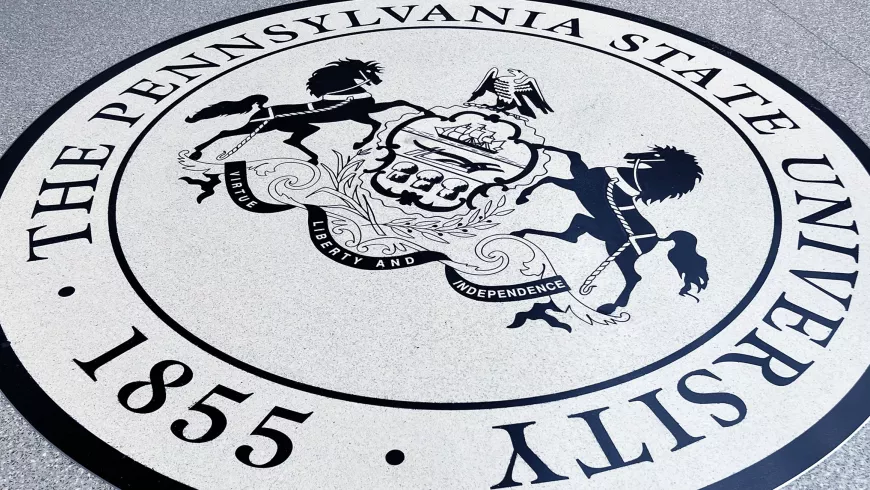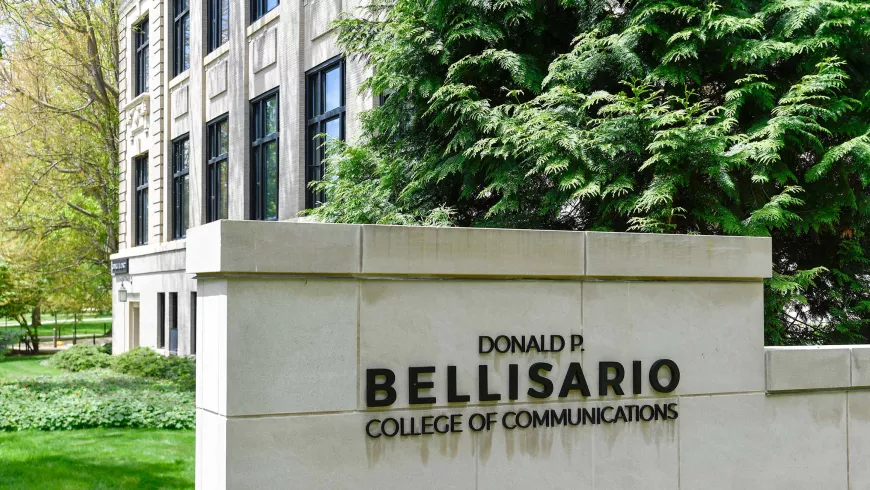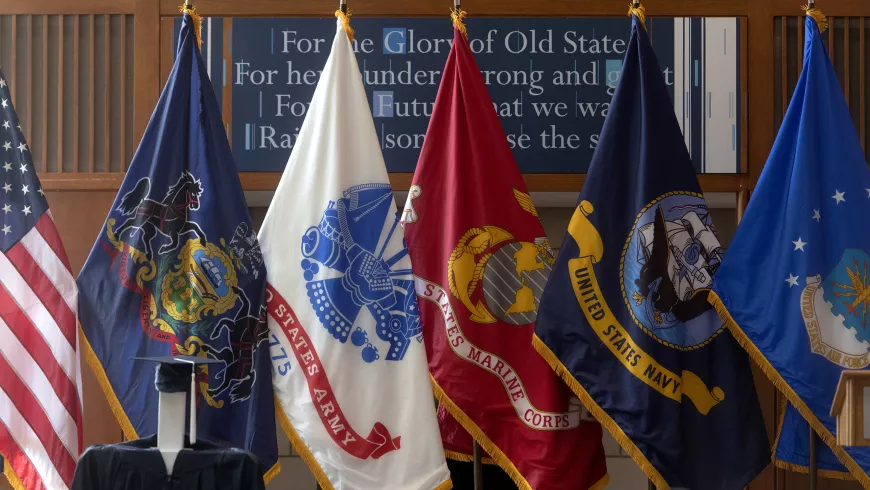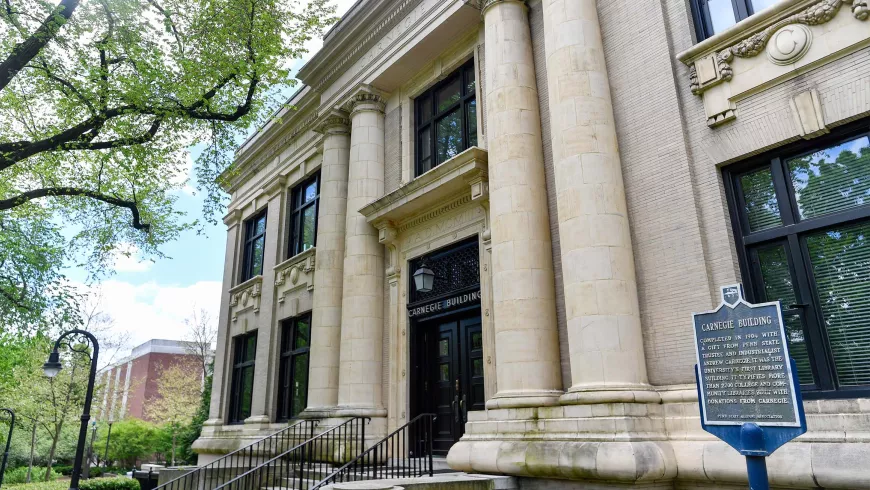100% Online
Complete your Penn State course work at your own pace and 100% online.
Application deadline
Credits and costs
Nationally Recognized

Gain Skills to Become a Voice of Truth in the Age of Digital Journalism
Write and produce content for digital journalism organizations.
Engage audiences using technology.
Fine tune your communication skills.
Apply multimedia skills to research, develop, and create compelling pieces.
Understand ethics and laws regarding freedom of speech and the press.
Customize Your Course List
Customize Your Course List
Penn State understands that you have unique aspirations. Specialized course work in this online digital journalism degree program can allow deep dives into topics of interest to your future and goals.
Choose course work from topic areas such as:
- digital journalism: Develop the fundamental skills required to pursue a journalism and online media career with courses such as news writing and reporting, strategic communications, and news editing.
- visual media: Prepare for a career as a content producer by learning how to use striking imagery to engage viewers with courses in photojournalism and multimedia journalism.
- media management: Learn to direct, execute, and track campaigns for media companies through courses focused on digital media metrics and management, idea development and media writing, and telecom leadership.
The Bachelor of Arts in Digital Journalism and Media program requires you to complete a minimum of 120 credits.
If you are a transfer student, the number of credits you will have to take will vary according to the courses you transfer into the degree program. Once you are admitted into the degree program, an assigned academic adviser will help you with remaining requirements.
Students can earn up to six (6) COMM credits through the credit-by-portfolio process. However, it is important for students to know that completing the credit-by-portfolio process does not guarantee that the credits will be awarded.
A grade of C or better is required for all courses in the major.
Prescribed Courses (19 credits)
- 1credit
Grammar, punctuation, spelling, and word usage skills required of journalists.
- 3credits
The development of electronic media and telecommunications, emphasizing social, economic, political and global impact.
- 3credits
News and news values; legal and ethical problems of reporting; writing and reporting news for the mass media.
- Prerequisite
COMM 160 and (ENGL 15 or ENGL 30)
- 3credits
Photography for communication in print and online; creating photographs for newspapers, magazines and the web; digital camera and software skills.
- Prerequisite or Concurrent
COMM 260W
- 3credits
The course introduces how journalists work with the tools of multimedia and how multimedia is changing journalism.
- 3credits
Students will evaluate content creation and distribution methods and demonstrate proficiency across emerging digital products and services.
- 3credits
Ethical problems in the practice of journalism; principal public criticisms of news media; case study approach.
Additional Courses (select 9 credits)
- 3credits
Introduction to the pre-production, production, and post production techniques when creating video content.
- or:3credits
Techniques in reporting news and trends at the local, regional, and county levels. Emphasis on both deadline and interpretive reporting.
- Prerequisite
COMM 260W
- or:3credits
Concepts and procedures involved in processing news for various news media, but with emphasis on print media editing.
- Prerequisite
COMM 260W
- 3credits
Analysis of audience data for traditional and new media to create metrics for advertising, content marketing, and audience analysis.
- or:3credits
Produce data-driven stories by demonstrating proficiency in sorting, filtering and using tools such as Structured Query Language, Chartbuilder, Tableau and Carto to query databases, as well as build charts and maps.
- Prerequisite
COMM 260W
- 3credits
Nature and theories of law; the Supreme Court and press freedom; legal problems of the mass media.
- or:3credits
Development in the law, policy, and business of Internet-mediated communications and commerce; emphasis on impact on existing legal, regulatory, and economic models.
- Prerequisite
ENGR 310 or COMM 180 or COMM 271 or MGMT 215
Supporting Courses (select 12 credits)
- 3credits
Learn how to write science stories that are accurate, clear, and compelling.
- 3credits
Introduction to basic principles of management as they apply in electronic media industries.
- Prerequisite
COMM 180
- 3credits
Idea conception, writing, and editing of magazine stories.
- Prerequisite
COMM 260W
- 3credits
Development of an informed and critical approach to photocommunication; individual and team projects, seminars, and critiques.
- Prerequisite
Enforced Prerequisite at Enrollment: COMM 269
Electives (select 11 credits)
Students should choose an additional 11 credits to satisfy the electives requirement.
General Education Requirements
Some General Education requirements may be satisfied by courses required for the major. Students should work with an adviser to select courses.
- Foundations: 15 credits
All courses require a grade of C or better. Inter-Domain courses may not be used for foundations requirements.- Writing/Speaking: 9 credits
- Quantification: 6 credits
3-6 credits are selected from mathematics, applied mathematics, and statistics; 3 credits may be selected from computer science or symbolic logic.
- Knowledge Domains: 15 credits
Inter-Domain courses may not be used for knowledge domain requirements.- Health and Wellness (GHW): 3 credits
- Natural Sciences (GN): 3 credits
- Arts (GA): 3 credits
- Humanities (GH): 3 credits
- Social and Behavioral Sciences (GS): 3 credits
- Integrative Studies: 6 credits
- Inter-Domain course work: 6 credits
- Exploration: 9 credits
- Natural Sciences (GN) (may be Inter-Domain): 3 credits
- GA, GH, GN, GS, and Inter-Domain courses: 6 credits
May include 3 credits of World Language course work beyond the requirements of the student’s degree program or at the 12th credit level, whichever is higher.
These General Education Requirements are for students who started in summer 2023 or later. Students who started earlier can review the prior version of the general education requirements.
Bachelor of Arts Degree Requirements
Some Bachelor of Arts requirements may be satisfied by courses required for the major, General Education courses, or electives. Students should work with an adviser to select courses.
- Foreign Language: 0–12 credits
Students must attain 12th credit level of proficiency in one foreign language. - B.A. Fields: 9 credits
Humanities, Social and Behavioral Sciences, Arts, Foreign Languages, Natural Sciences, Quantification (cannot be taken in the area of the student's primary major; foreign language credits in this category must be in a second foreign language or beyond the 12th credit level of proficiency in the first language) - Other Cultures: 0–3 credits
Select 3 credits from approved list. Students may count courses in this category in order to meet other major, minor, elective, or General Education requirements, except for the General Education US/IL requirement.
Course Availability
If you're ready to see when your courses will be offered, visit our public LionPATH course search (opens in new window) to start planning ahead.
Start or Advance Your Career

Start or Advance Your Career
Graduates can pursue careers in a variety of fields depending on their aspirations and course work with this degree in journalism and the support of Penn State career resources.
Job Titles Related to This Degree
Your ability to create, execute, and evaluate communication strategies can make you a valuable asset for news outlets, businesses, government entities, and nonprofit organizations. The following roles are often held by people with this type of degree:
- Digital Media Production Manager
- Digital Media Programming Director
- Journalist
- Reporter
- Social Media Strategist
- Web Editor
Employment Outlook for Occupational Fields Related to This Degree
Estimates of employment growth and total employment are provided by the U.S. Bureau of Labor Statistics and are subject to change. While these occupations are often pursued by graduates with this degree, individual outcomes may vary depending on a variety of factors. Penn State World Campus cannot guarantee employment in a given occupation.
Producers and Directors
News Analysts, Reporters, and Journalists
Editors
Career Services to Set You Up for Success

From the day you're accepted as a student, you can access resources and tools provided by Penn State World Campus Career Services to further your career. These resources are beneficial whether you're searching for a job or advancing in an established career.
- Opportunities to connect with employers
- Career counselor/coach support
- Occupation and salary information
- Internships
- Graduate school resources
Upcoming Events
Ready to Learn More?
Get the resources you need to make informed decisions about your education. Request information on this program and other programs of interest by completing this form.
Ready to take the next step toward your Penn State bachelor's degree?
Costs and Financial Aid
Costs and Financial Aid
Learn about this program's tuition, fees, scholarship opportunities, grants, payment options, and military benefits.
Costs and Financial Aid
Undergraduate Tuition
Undergraduate tuition is calculated based on the number of credits for which you register and the number of total credits you have accrued at or transferred to Penn State.
Tuition is due shortly after each semester begins and rates are assessed every semester of enrollment.
2024–25 Academic Year Rates
| How many credits do you plan to take per semester? | If you have 59 or fewer credits | If you have 60 or more credits |
|---|---|---|
| 11 or fewer | $632 per credit | $678 per credit |
| 12–19 | $7,678 per semester | $8,288 per semester |
2025–26 Academic Year Rates
| How many credits do you plan to take per semester? | If you have 59 or fewer credits | If you have 60 or more credits |
|---|---|---|
| 11 or fewer | $638 per credit | $685 per credit |
| 12–19 | $7,755 per semester | $8,371 per semester |
Undergraduate students taking more than 19 credits will be charged the flat tuition rate plus the regular per credit hour rate for each credit above 19.
Financial Aid and Military Benefits
Some students may qualify for financial aid. Take the time to research financial aid, scholarships, and payment options as you prepare to apply. Federal financial aid may only be used to pay for credits used to satisfy program requirements.
Military service members, veterans, and their spouses or dependents should explore these potential military education benefits and financial aid opportunities, as well.
Additional Cost of Attendance Details
To view the detailed list of cost of attendance elements:
- visit the Tuition Information site
- click the plus sign to expand the table
- select a semester from the World Campus row
Set Your Own Pace

Set Your Own Pace
Whether you are looking to finish your program as quickly as possible or balance your studies with your busy life, Penn State World Campus can help you achieve your education goals. Many students take one or two courses per semester.
Our online courses typically follow a 12- to 15-week semester cycle, and there are three semesters per year (spring, summer, and fall). If you plan to take a heavy course load, you should expect your course work to be your primary focus and discuss your schedule with your academic adviser.
To Finish Your Degree in Two to Three Years
- Take 6 courses each semester
To Finish Your Degree in Three to Four Years
- Take 4–5 courses each semester
To Finish Your Degree in Five or More Years
- Take 2–3 courses each semester
Timelines may vary for students transferring credits from another school or based on course availability.
Convenient Online Format
This program's convenient online format gives you the flexibility you need to study around your busy schedule. You can skip the lengthy commute without sacrificing the quality of your education and prepare yourself for more rewarding career opportunities without leaving your home.
A Trusted Leader in Online Education
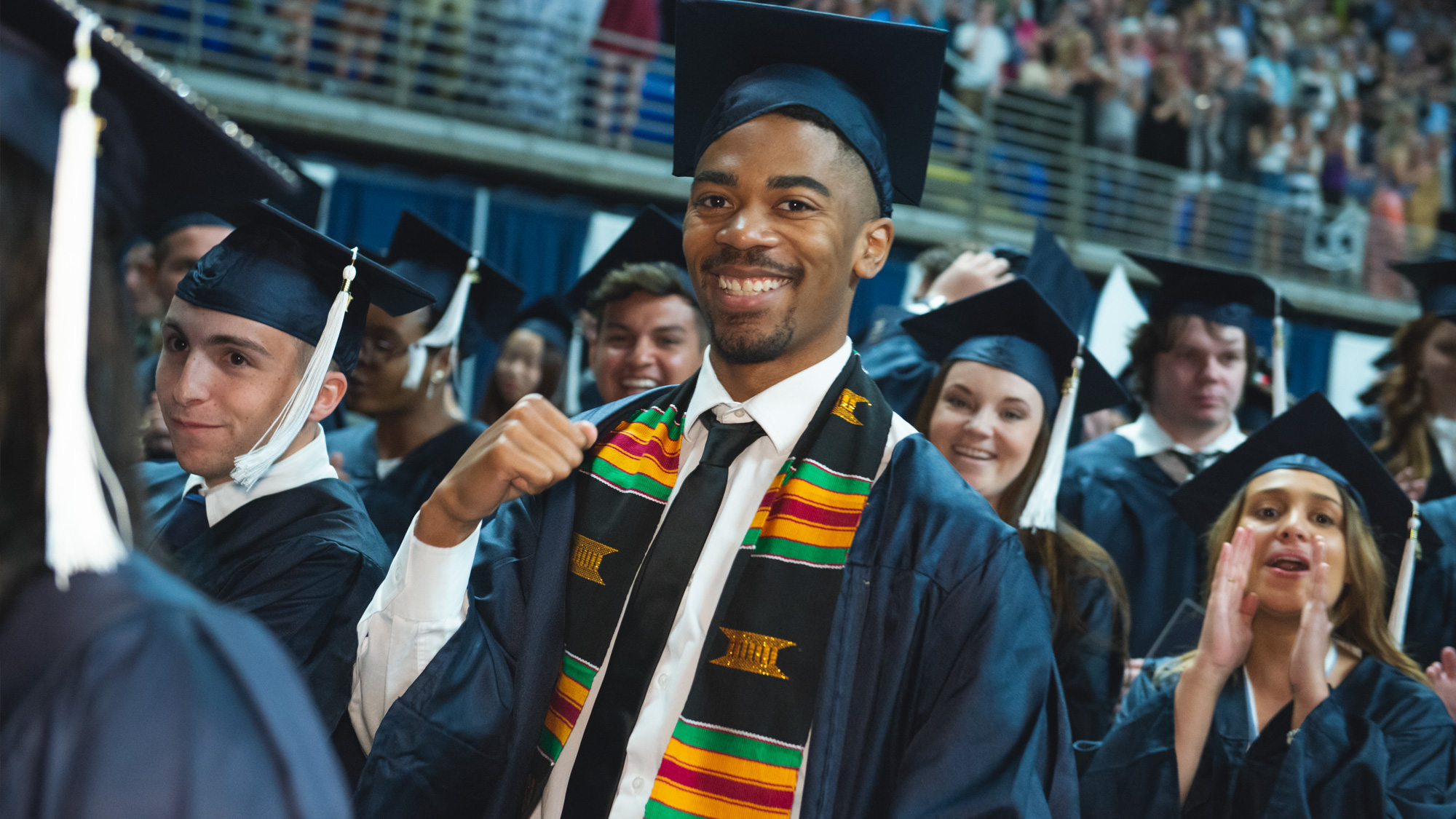
Penn State has a history of more than 100 years of distance education, and World Campus has been a leader in online learning for more than two decades. Our online learning environment offers the same quality education that our students experience on campus.
How to Apply to Penn State

How to Apply to Penn State
Apply by October 31 to start January 12
Application Instructions
Deadlines and Important Dates
Complete your application and submit all required materials by the appropriate deadline. Your deadline will depend on the semester you plan to start your courses.
Spring Deadline
Apply by October 31 to start January 12Summer Deadline
Apply by March 15, 2026, to start May 18, 2026
New students are encouraged to complete the FAFSA by March 1. Please visit the Office of Student Aid website for more information about applying for financial aid and recommended deadlines.
Steps to Apply
To apply for this program, you must be a high school graduate, or have completed your GED.
You will need the following items to complete your application:
High school transcripts or GED transcript — First-year applicants are required to submit Self-Reported Academic Records (SRAR) when applying. Official high school transcripts for first-year applicants will only be required at the time a student accepts an offer of admission to Penn State.
Transfer international students will need to submit their high school transcript before their application can be reviewed.
Official college or university transcripts and/or official military transcripts (if applicable) — All college or university transcripts are required regardless of the length of time that has passed, the grades earned, or the accreditation of the institutions attended. Acceptance of transfer credit toward your degree is subject to final approval by the academic department. For detailed information, see the Transfer Students page.
Transcripts not in English must be accompanied by a certified translation.
English Proficiency — The language of instruction at Penn State is English. With some exceptions, international applicants must take and submit scores for the Test of English as a Foreign Language (TOEFL) or International English Language Testing System (IELTS). Minimum test scores and exceptions are found in the English Language Proficiency section on the Undergraduate Admissions International Requirements page. Visit the TOEFL website for testing information. Penn State's institutional code is 2660.
To begin the online application, you will need a Penn State account.
Create a New Penn State Account
If you have any problems during this process, contact an admissions counselor at [email protected].
Please note: Former Penn State students may not need to complete the admissions application or create a new Penn State account. Please visit our Returning Students page for instructions.
Accessing MyPennState
The MyPennState Portal provides access to our online admissions services. Before accessing MyPennState, you must have a Penn State account that will be used to access all Penn State systems. After creating an account, you will receive a unique Penn State User ID. You will need to enter your User ID followed by @psu.edu when signing in to MyPennState and other Penn State sites. For example, you should be entering something like '[email protected]' in the Sign In field.
The application consists of six sections:
- Application Setup
- Program of Study
- Citizenship and Residency
- Academics and Experience
- Miscellaneous
- Review and Submit
Application Setup
Be sure to select "Online" for the "How would you like to complete your degree" question if you plan to attend Penn State World Campus.
The rest of this section will ask some basic questions about your education experience and military affiliation.
Program of Study
You will choose the degree type and then the starting semester.
Your starting campus will be selected as Penn State World Campus by default as long as you picked "Online" in your Application Setup. Click Continue.
On the Choose a Program page, select your intended major from the list.
Review your selection on the summary screen and click Continue to move on to the Citizenship and Residency section.
Citizenship and Residency
Complete the series of questions about your citizenship status, demographic information, Pennsylvania residency status, and family history.
Academics and Experience
You will need to enter academic experience information about your high school and any attempted courses at a college or university after high school.
The Education Gap Statement offers a place to explain any time that has elapsed between your high school graduation and your anticipated enrollment at Penn State. Please provide a summary of why that gap occurred. Some examples that would explain a gap in your education include work, family, attending another college or university, etc.
Miscellaneous
In the Miscellaneous section, you will provide any program-specific requirements (e.g., a personal statement), information about activities, and financial aid information.
Review and Submit
Review your information, digitally sign your application, and provide payment for the application fee ($65 domestic or $75 international).
High School Transcripts and Academic Record
After your application is completed, you will also need to self-report your high school course work before the application deadline. You will be directed to fill out the Self-Reported Academic Record (SRAR). It is helpful to have a high school transcript available when completing this section. In the third section, you'll select your program of study and campus.
Official high school transcripts or GED transcript, along with records from high school, are required, regardless of the length of time that has passed.
Include any college/university transcripts (required), military transcripts, and Proof of English Language proficiency (if applicable). SAT/ACT scores are not required if you are identified as an adult learner or transfer student.
All official documents should be sent to:
Undergraduate Admissions Office
The Pennsylvania State University
201 Shields Building
University Park, PA 16802You can also have your transcripts sent electronically through Parchment, eScript-Safe, or the National Clearinghouse directly to Penn State from the college/university where course work was attempted.
Acceptance
After receiving your application, application fee, and all required materials, your application will be evaluated for admission. You can check your application status online. This will provide the most up‐to‐date information about the status of your application and is updated once daily, before 8:00 a.m. (ET). Once a decision has been made regarding your application, it will be available to you through the MyPennState portal.
For information on when you can expect an admissions decision, visit the Dates and Deadlines page of the Undergraduate Admissions website. Make sure you click the "+" sign to see these dates for World Campus Applicants (First-Year and Transfer).
5. Complete the application.
Admissions Help
If you have questions about the admissions process, contact an admissions counselor at [email protected].
Contact Us

Contact Us
Have questions or want more information? We're happy to talk.
To learn more about the Bachelor of Arts in Digital Journalism and Media, please contact:
World Campus Admissions Counselors
Phone: 800-252-3592
Email: [email protected]
Michelle Baker, Ph.D.
Assistant Teaching Professor and Lead Faculty
Donald P. Bellisario College of Communications
The Pennsylvania State University
115 Carnegie Building
University Park, PA 16802
Email: [email protected]
Learn from the Best
Learn from the Best
The Bachelor of Arts in Digital Journalism and Media program is offered by Penn State World Campus in partnership with the Donald P. Bellisario College of Communications, which is the largest accredited school in the field.
Faculty
Michelle Baker
- DegreePh.D., Mass Communications, Penn State
- DegreeM.S., Communications Studies, Shippensburg University
- DegreeB.A., Communications/Journalism, Shippensburg University
Dr. Michelle Baker is the director of eLearning Initiatives and an assistant teaching professor in the Department of Advertising and Public Relations at the Donald P. Bellisario College of Communications. She oversees the college's portfolio of online degree programs, which includes a B.A. in Digital Journalism and Media, an MPS and B.A. in Strategic Communications, and a media studies minor. Dr. Baker has been teaching both in-residence and online classes for Penn State since 2009, and she has more than 20 years of teaching and administrative experience in higher education. She has experience working as a journalist and freelance writer, and she served as the assistant editor for Bucknell University’s alumni magazine. She teaches COMM 160.
Doug Barkey
- DegreeMFA, Photography, University of Iowa
- DegreeM.A., Sculpture, University of Iowa
- DegreeB.A., Fine Arts, Bethel University
Professor Doug Barkey has spent decades working in photography and digital media among multiple cultures and languages. His work has been exhibited in one-person shows at the Museo de Arte Moderno in Santo Domingo, Dominican Republic, along with galleries in Maine, Iowa, Michigan, and New Mexico. Professor Barkey’s work includes advertising, portraiture, landscape, and documentary photography. He has an M.A. in Sculpture and an MFA in Photography from the University of Iowa. He teaches COMM 215 and COMM 269.
Curtis Chan
- DegreeM.A., Media Studies, Penn State
- DegreeB.A., Journalism, Penn State
Professor Curtis Chan is the senior manager for public relations at Penn State, where he develops and implements university-wide, multichannel communications strategies. He serves as the senior communications adviser to administrators, crafting executive communications for University leaders, including the President. Professor Chan also provides high-level oversight and creative vision for Penn State Today,the University's flagship news publication. Prior to this position, Professor Chan served as the manager of internal communications at Penn State. He has been teaching for the Donald P. Bellisario College of Communications for two decades. He teaches COMM 467.
John Chapin
- DegreePh.D., Communication, Information, and Library Studies, Rutgers University
- DegreeM.S., Communications Studies, Shippensburg University
- DegreeB.S., Education, Bloomsburg University
Dr. John Chapin is a professor of communications and the associate director of academic affairs for the Penn State Beaver campus. He earned his Ph.D. from Rutgers University in 1998. Dr. Chapin conducts applied community-based research in violence prevention education. He is the recipient of the Stephen Schafer National Research Award for significant contributions to the field of crime victim rights from the National Organization for Victim Assistance (NOVA). He has also received legislative citations for community service from both Houses of Congress. Dr. Chapin teaches COMM 150N.
Anne Doris
- DegreeMBA, Marketing Management, Long Island University
- DegreeB.A., Journalism, City College of New York
Professor Anne Doris is an assistant teaching professor in the Department of Telecommunications and Media Industries at the Donald P. Bellisario College of Communications. A proven executive in the private sector — most recently with Sodexo USA as a regional vice president in the company's health care division — Professor Doris brings valuable experience and perspectives to Penn State. Professor Doris’ background also includes experience with an online education service provider and nine years with Cox Communications, one of the nation’s largest cable companies, which further enhances the expertise and value she brings as a University faculty member. She teaches COMM 380.
Jenna Grzeslo
- DegreePh.D., Mass Communications, Penn State
- DegreeM.A., Communication, University of Hartford
- DegreeB.A., Political Science, Communication Arts, University of Wisconsin-Madison
Dr. Jenna Grzeslo is the senior manager of research and learning at BRAC USA. Dr. Grzeslo works closely with the Brac Institute of Governance and Development at Brac University, where she supports the Women’s Economic Empowerment and Digital Finance (WEE-DiFine) initiative. Dr. Grzeslo develops proposals for research and innovation projects in partnership with various BRAC entities and teams. Dr. Grezslo’s work has been published in numerous journals, including Computers in Human Behaviorand Digital Policy, Regulation, and Governance. She has also served as the managing editor of the Journal of Information Policy, a research fellow at UNESCO, and the coordinator for the Information and Communication Technology for Development (ICT4D) Consortium at Penn State. She teaches COMM 310.
Shannon Kennan
- DegreePh.D., Mass Communications, Penn State
- DegreeM.Ed., Counseling Psychology, College Student Personnel Administration, James Madison University
- DegreeB.A., Early Childhood Education, University of Richmond
Dr. Shannon Kennan is a teaching professor and serves as the first-year seminar coordinator and the curriculum coordinator for journalism. Her teaching expertise focuses on applying ethics and DEIB to mass comm industries. Shannon's educational experiences provide a mix of skills that allow her to bring a student-centered focus to her teaching. She has worked in higher education in a variety of administrative and teaching roles since 1995 and joined the Donald P. Bellisario College of Communications in 2011 as the director of eLearning Initiatives to build the existing portfolio of online and hybrid courses and programs.
Rex Martin
- DegreePh.D., Interdisciplinary Studies in Mass Communications, Penn State
- DegreeM.Litt., Modern History, University of St. Andrews, Scotland
- DegreeB.A., Modern History, Carroll College
Dr. Rex Martin has spent most of his adult life playing, studying, designing, and writing about games. He has worked for various game companies and spent 13 years as the managing editor at the Avalon Hill Game Company, where he was responsible for all the rulebooks, box copy, and a bi-monthly magazine devoted to military history and simulations. In 2001, he was awarded a doctoral degree from Penn State. His dissertation was titled "Cardboard Warriors: A Cultural History of American Wargaming, 1958–1998." After nearly a decade as a professor, he became the senior writer at Firaxis Games. He teaches COMM 190.
Jill Mott
- DegreeM.A, Art Education, San Jose State University
- DegreeB.S., Communications Photography, Syracuse University
Professor Jill Mott is a visual multimedia journalist, photographer, and photo educator. She specializes in lifestyle portrait and editorial photography featuring children, seniors, families, and events, as well as documentary photography. Professor Mott has more than two decades of experience as a photojournalist and has traveled the world taking photographs and creating live and recorded vlogs. She brings her curiosity and passion to tell authentic stories through her photography. She teaches COMM 215 and COMM 269.
David Norloff
- DegreeMBA, Marketing, Rutgers University
- DegreeB.S., Industrial Engineering, Penn State
Professor David Norloff is an assistant teaching professor in the Department of Telecommunications and Media Industries at the Donald P. Bellisario College of Communications. He is a wireless industry veteran, with a 20-year career leading technology and wireless initiatives. His diverse corporate experience includes leadership positions in management consulting, product strategy, and product development. While at Nextel, he led the Inter-Carrier Messaging, Multimedia Messaging Service (MMS) product launches and served on the 4G technology strategy team after the Sprint merger. He received the Deans’ Excellence Award for Outstanding Faculty Associate in 2014 and the Deans’ Excellence Award in Teaching in 2019. He is actively engaged as a mentor for Happy Valley LaunchBox and served as the first faculty co-chair for Penn State Startup Week 2021. He teaches COMM 280.
Stacie Shain
- DegreeM.A., Journalism, Indiana University Bloomington
- DegreeB.A., Mass Communication, Bellarmine University
Professor Stacie Shain is an award-winning communications professional with extensive experience in sports reporting, public relations, and corporate communication. She has written for daily newspapers across the United States and served as the sports editor and managing editor of a newspaper in Missouri. Professor Shain also worked as a public affairs specialist, public affairs officer, and advertising and public affairs chief in the U.S. Army’s Recruiting Command. She won numerous awards from that command, including Program Specialist of the Year in 2008. Professor Shain also managed public and community relations for the Warrior Transition Battalion at Fort Carson, Colorado, and worked on the first-ever Warrior Games. She teaches COMM 412.
Matthew Solovey
- DegreeMPS, Strategic Communications, Penn State
- DegreeB.S., Organizational Leadership, Penn State
Professor Matthew Solovey has more than 25 years of communication strategy experience. Starting his career as a journalist, Professor Solovey launched a community newspaper when he was fresh out of college. The paper invested in a former coal town that had seen its best days behind it and provided Matthew with a solid foundation for more than 15 years of community journalism experience. Ultimately, Matthew launched two newspapers and rehabilitated three before embarking on a career in marketing and communications in health care and academia. He currently is a regional marketing manager at Highmark Health. He teaches COMM 260W and COMM 271.
Dan Yesenosky
- DegreeM.A., Mass Communication, University of Missouri-Columbia
- DegreeB.A., Broadcast Journalism, Penn State
Professor Dan Yesenosky has more than ten years of professional experience in journalism and communications, currently serving as assistant director of external communications for Capgemini. Prior to his current role, he worked in corporate communications for a technology company specializing in cybersecurity, and he was a TV news reporter for NBC affiliates in Charlotte and Greenville, North Carolina. While progressing through his career, Dan earned his master’s degree in media management online through the University of Missouri. He completed his bachelor’s degree at Penn State, attending the University Park campus. Professor Yesenosky teaches COMM 260W, COMM 271, and COMM 409.
Will Yurman
DegreeB.A., Biology, University at Albany, SUNYProfessor Will Yurman worked in journalism for more than two decades as both a still photographer and multimedia producer. He was a staff photographer at the Democrat & Chronicle in Rochester, New York, and did freelance work for the Associated Press (AP). Professor Yurman also spent three years in the Middle East covering the Palestinian-Israeli conflict. His work has been exhibited at The George Eastman House International Museum of Photography and Film, and it has been recognized in the Best of Photography contest and the Picture of the Year International contest. Professor Yurman’s skills include documentary filmmaking, still photography, writing, editing, web design, and 360-degree augmented reality video. He teaches COMM 215, COMM 269, and COMM 469.
News

